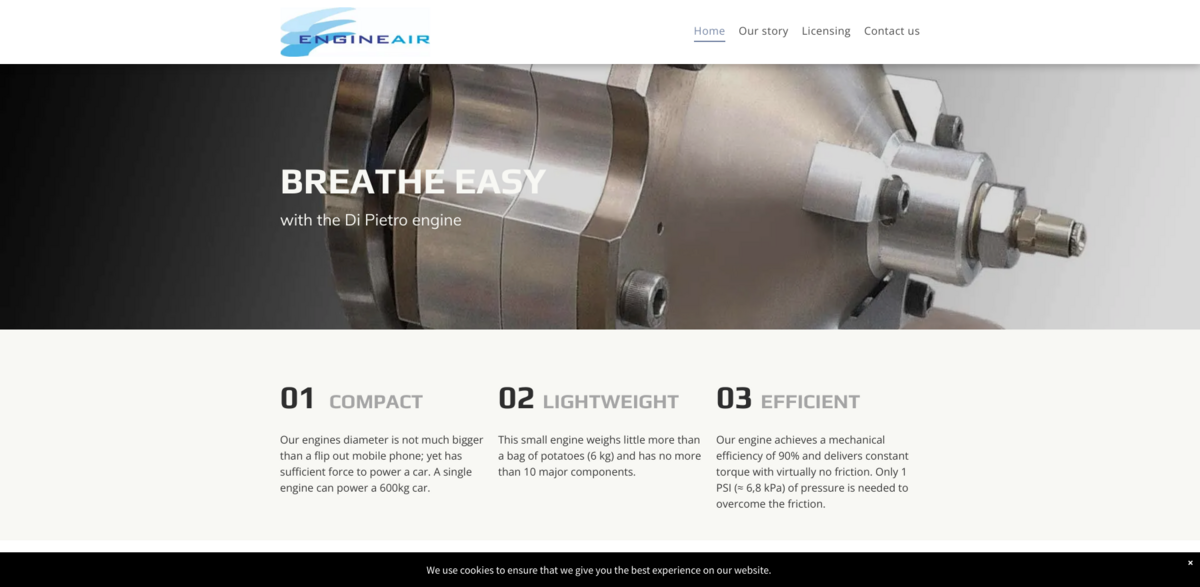What is the Di Pietro Engine by Engineair?
Engineair has developed a groundbreaking rotary engine known as the Di Pietro engine, designed to breathe new life into the way power is generated. This compact marvel isn’t much bigger than a flip-out mobile phone, yet it packs enough punch to power a 600kg car. What sets it apart? It runs entirely on clean compressed air—no combustion fuels, no toxic batteries—making it a truly environmentally friendly solution. The engine’s cylindrical shaft driver moves eccentrically, driven by air pressure on its outer wall, which in turn powers the engine shaft through rolling elements cushioned by a thin film of air. Timing is controlled by a slotted timer rotating at the engine’s speed, allowing precise control over air inlet and exhaust. This clever design means the engine can be scaled and tuned for various applications, from stationary power sources to mobile vehicles.
Main Benefits of the Di Pietro Engine
Here’s a quick snapshot of what makes this engine stand out:
- Compact Size: Diameter barely bigger than a flip phone.
- Lightweight: Weighs just about 6 kg—roughly the weight of a bag of potatoes.
- Efficiency: Mechanical efficiency hits 90%, with constant torque and almost no friction.
- Torque: Maximum torque of 70 Nm at 8.8 bar air pressure, and 40 Nm at 1500 rpm.
- Components: Only 10 major parts, most of which don’t even touch each other.
- Environmental Impact: Uses 100% eco-friendly lubricant and clean compressed air as fuel.
- Control: Instant torque at zero RPM with smooth start and acceleration control.
How Does the Di Pietro Engine Work?
The magic lies in the engine’s unique rotary mechanism. The cylindrical shaft driver moves eccentrically, pushed by air pressure on its outer wall. This movement drives the engine shaft via two rolling elements mounted on bearings. The rolling motion is cushioned by a thin air film, reducing friction to nearly nothing. Air inlet and exhaust are timed by a slotted timer on the output shaft, which spins at the same speed as the engine itself. By adjusting the air inlet duration, the engine can either boost torque with a longer air supply or increase efficiency with a shorter inlet period. This flexibility means power and energy consumption can be balanced perfectly depending on what’s needed.
Applications and Licensing
The Di Pietro engine is versatile, fitting both stationary and mobile applications. It’s especially suited for industries where electric motors or combustion engines pose risks—think mining, petrochemical, and pharmaceutical sectors where fire, contamination, or explosions are concerns. Currently, Engineair is focused on licensing the technology rather than manufacturing engines themselves. Licensing terms vary depending on application, region, exclusivity, and production volume. The goal? To create deals that benefit everyone involved, including the environment and end users.
Addressing Skepticism and Common Questions
People often find it hard to believe that a tiny engine running on compressed air can power a vehicle. There’s also confusion about how compressed air can be stored and used efficiently. Engineair has videos demonstrating the engine’s capabilities, which can be found on their YouTube channel. The engine produces constant torque throughout its cycle, and its power output can be increased by raising inlet air pressure. Despite its small size—only 266 cubic centimeters—it delivers impressive performance. Plus, it’s up to 400% more efficient than existing air piston motors and weighs just a tenth of comparable engines. And yes, it does require lubrication, but only with environmentally friendly oils.
Environmental and Sustainable Impact
- SDG 7: Affordable and Clean Energy – Uses clean compressed air as fuel.
- SDG 9: Industry, Innovation, and Infrastructure – Innovative rotary engine technology.
- SDG 11: Sustainable Cities and Communities – Potential for clean transportation solutions.
- SDG 12: Responsible Consumption and Production – Minimal components and eco-friendly lubricants.
- SDG 13: Climate Action – Reduces reliance on fossil fuels and toxic batteries.
The Future of Clean Power with Engineair
The Di Pietro engine represents a shift towards sustainable, efficient power generation. It offers a compelling alternative to petrol and electric engines, especially as concerns grow over environmental damage caused by fossil fuels and battery waste. The engine’s ability to generate electricity is promising, though large-scale electricity production is better suited to systems like the Organic Rankine Cycle combined with this engine. For those curious about the future of clean, affordable, and scalable power, Engineair’s technology is definitely worth watching. It’s not just an engine—it’s a glimpse into a cleaner, smarter future.





















